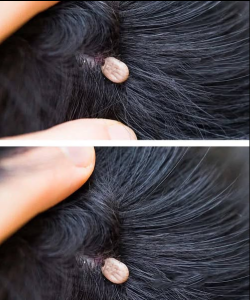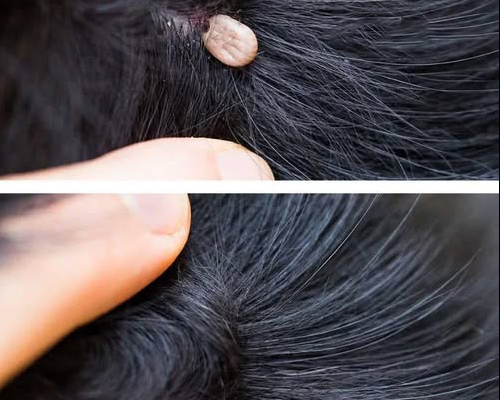
Strange Finding in My Child’s Hair — Should We See a Doctor?
As parents, we often come across little surprises when caring for our children—scrapes, bruises, or even odd bumps that seem to appear overnight. But few things can cause quite as much alarm as discovering something strange in your child’s hair. Whether it’s an unusual patch, strange debris, or something that looks like it’s moving, your first instinct is usually panic. Before jumping to conclusions, it’s important to stay calm, assess the situation, and know when to call a doctor. Here’s a closer look at the possible causes, what to do at home, and when professional medical care is truly necessary.
1. Common Causes of Strange Findings in a Child’s Hair
Not every oddity in your child’s hair is a medical emergency. Sometimes, the explanation is harmless or easily treatable. Here are the most common possibilities:
A. Head Lice
One of the most frequent culprits is head lice. These tiny, wingless insects feed on human blood and lay eggs (nits) close to the scalp. Lice are common among children, especially in schools or daycare centers where close contact is unavoidable.
What to look for:
-
Tiny white or yellowish nits stuck firmly to hair shafts.
-
Itching, particularly behind the ears and at the nape of the neck.
-
Small red bumps or irritation on the scalp.
If you suspect lice, check other family members as well. Over-the-counter treatments and diligent combing can usually resolve the issue, though in severe cases, a doctor may prescribe stronger medication.
B. Dandruff or Scalp Build-Up
White flakes or crusty patches can often be mistaken for lice or other issues, but dandruff (seborrheic dermatitis) is very common in children. It can be caused by dry skin, excess oil, or even certain shampoos.
What to look for:
-
Flaky white or yellowish scales.
-
Mild itching without visible insects.
-
Sometimes redness or greasy patches on the scalp.
Mild dandruff can be treated with gentle shampoos, but if flakes persist or worsen, a pediatrician or dermatologist may recommend medicated options.
C. Fungal or Bacterial Infections
If your child’s scalp looks red, swollen, or has circular bald patches, it might be a fungal infection like tinea capitis (ringworm of the scalp). This infection spreads easily among children through shared hats, combs, or bedding.
What to look for:
-
Round or scaly bald spots.
-
Red, itchy, or crusted areas.
-
Possible pus or discharge in severe cases.
In these situations, home remedies won’t help. You’ll need prescription antifungal medication from a doctor. If untreated, it can spread and cause permanent hair loss in the affected areas.
D. Foreign Objects or Environmental Debris
Sometimes the strange thing you find isn’t biological at all. Children are explorers—they play outside, roll on the ground, or do craft projects that can leave glitter, grass, paint, or even sticky substances tangled in their hair.
What to look for:
-
Hard or sticky spots that don’t match the hair texture.
-
No signs of itching, redness, or irritation.
Try removing the substance gently with warm water and a mild conditioner. If it’s gum or glue, applying olive oil or peanut butter can help loosen it before combing. No doctor needed here—just patience.
E. Skin Conditions or Allergic Reactions
Some children develop bumps or rashes on the scalp due to allergies from shampoos, hair products, or even laundry detergents. Eczema can also appear on the scalp.
What to look for:
-
Red, itchy, or dry patches.
-
Oozing or crusting in severe cases.
-
History of other allergic skin reactions.
Switching to fragrance-free, gentle products can help, but if the irritation persists or worsens, a doctor can prescribe soothing creams or antihistamines.
2. When to Call a Doctor Immediately
While many scalp issues are minor, there are times when medical attention is important. You should contact your pediatrician if you notice:
-
Pus, bleeding, or painful sores on the scalp.
-
Rapid hair loss or bald spots.
-
Severe itching that doesn’t improve after treatment.
-
Fever or swollen lymph nodes (could indicate infection).
-
Signs of a spreading rash to other parts of the body.
-
Something moving under the skin — which, though extremely rare, requires immediate medical evaluation.
If your child seems unusually tired, develops a fever, or the scalp issue is accompanied by behavioral changes, it’s best to get checked right away.
3. How to Examine Your Child’s Scalp at Home
If you find something odd in your child’s hair, follow these steps before rushing to conclusions:
-
Move to a well-lit area. Natural light helps you see the scalp clearly.
-
Use a fine-tooth comb to part the hair in small sections.
-
Check for patterns. Lice nits, for example, are evenly spaced and attached firmly to the hair. Dandruff flakes, on the other hand, can be brushed off easily.
-
Note any smells, oozing, or pain. These can indicate infection.
-
Take a photo if you’re unsure—this can help a doctor make a quicker diagnosis.
Remember: the goal is observation, not panic. Most scalp conditions look worse than they are.
4. Preventing Future Scalp Issues
You can’t protect your child from every little surprise, but a few good habits go a long way:
-
Regular hair washing: Use mild shampoos and rinse thoroughly.
-
Avoid sharing personal items: No sharing of combs, hats, or pillows.
-
Teach hygiene: Encourage your child to avoid scratching their scalp or touching others’ hair.
-
Check periodically: Especially if there’s a lice outbreak at school.
-
Use natural light: A quick weekly check after bath time helps catch problems early.
For children with sensitive skin, stick to hypoallergenic shampoos and avoid heavy oils or harsh chemicals.
5. Staying Calm as a Parent
It’s natural to worry when you notice something unusual on your child’s body. But most scalp issues—lice, dandruff, or mild irritation—are easy to treat with simple steps. The key is observation, gentle care, and knowing when to escalate.
Panicking or aggressively washing or combing the scalp can make matters worse. If you’re uncertain, there’s no harm in seeking medical advice. A quick visit or even a telehealth consultation can bring peace of mind and prevent unnecessary stress for both you and your child.
Conclusion
A “strange finding” in your child’s hair can be unsettling, but it doesn’t always signal something serious. From harmless dandruff to treatable infections, most causes are manageable with proper attention and care. The important thing is to stay calm, identify what you’re seeing, and consult a doctor when symptoms point to infection or discomfort.
Your vigilance as a parent makes all the difference. The next time you notice something odd in your child’s hair, take a deep breath, investigate carefully, and remember: reassurance and timely care go a long way in keeping your little one healthy and happy

